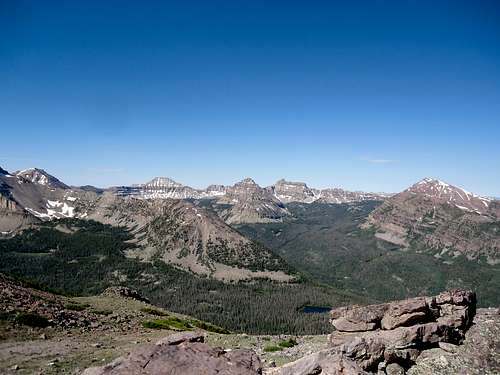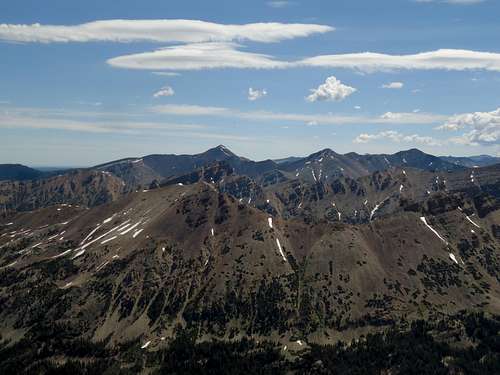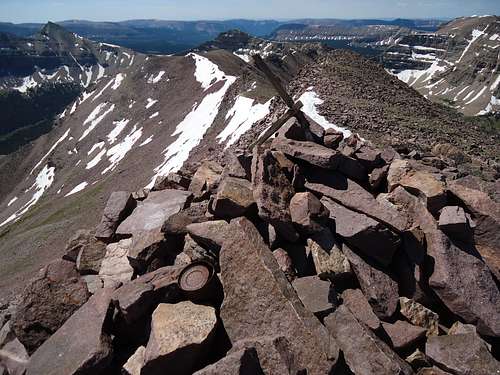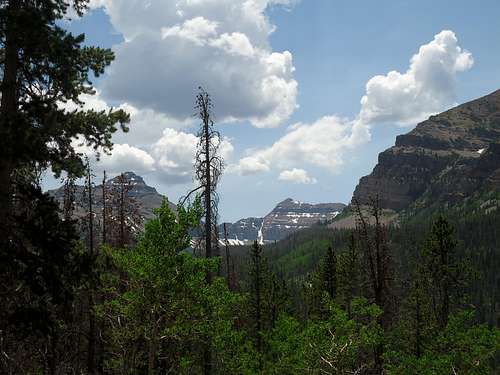Introduction
![Lamotte s Upper Ridge]() Lamotte Peak
Lamotte PeakEvery once in a while I climb a peak that involves more suffering than fun. Until June 29, 2013 my “most miserable ascent” prize went to my climb of Diamond Peak (ID) by a non-standard route. However, my recent experience on Lamotte Peak in the Uintas overtook the Diamond Peak epic, and literally blew it out of the water.
The Ascent
The day began like any other with an early rise and quick pack up of camp. The sky was clear and the temperature was nice and cool. When I arrived at the Christmas Meadows trailhead I quickly put together my gear and took of down the trail. The time was about 6:45 AM. My plan was to try a variation of the North ridge route by following the drainage South of Scow Lake and onto the ridge. This turned out to be a very nice and quick route despite the bushwhacking and deadfall. However, as the sun came up and it began to warm up the mosquitoes became very active. I dug through my pack looking for my repellent and realized that I had left it in my truck. Too far along to turn back I decided to press on and keep the mosquitoes at bay with my hands…yeah right!
I still made good time and in spite of my constant battle with the mosquitoes I made it to tree line just before 9 AM. Surprisingly the mosquitoes were just as active here as they were lower down in the basin. I still took a quick break to apply sunscreen and pressed on across the beautiful alpine tundra of Lamotte’s North ridge. Even at 11,500 ft. the sun was still scorching hot. It would only get worse as the day went on.
The final 1000 ft. are on a much narrower ridge. It was still only class 2 and was quite enjoyable, except for the darn mosquitoes that continued to plague me.
![Uinta Tundra]() Uinta Tundra
Uinta Tundra![First view of Lamotte]() First View of Lamotte
First View of Lamotte
I made it to the summit just after 10:30 AM and stayed there just shy of an hour. I decided it was time to head down when I noticed clouds building up to the South. Besides, even at nearly 13,000 ft. I was still being eaten alive by the ever persistent mosquitoes, especially since I wasn’t moving around.
![View West from Lamotte]() West View
West View![View East]() East View
East View![Lamotte s Summit]() The Summit
The Summit![Lamotte Splattski Shot]() Summit Splattski
Summit SplattskiThe Suffering Begins
![Down the West Face]() Long way down
Long way downI decided to take what I had been told was the quick way down by descending the West face of the peak. It’s much steeper but puts you on the Stillwater Fork trail fairly quickly. This is where the misery began in earnest.
![Still a Long Way Down]() Long way down still
Long way down still
The face consisted of typical loose, blocky Uinta talus that became more and more difficult to navigate the lower I went. It also became a lot steeper as I got lower. The going was very slow and it took a great deal of both physical and mental effort to make sure my footing was solid. This wasn’t a great place to slip and break a leg.
![Bushwhack]() Major Bushwhack
Major Bushwhack
While I was descending the clouds continued to build to the South and move closer. This encouraged me to try and move faster although it was difficult. To make matters worse, I was still constantly battling mosquitoes. If I concentrated on keeping my balance then my arms became mosquito pin cushions. A couple times I had had enough of the mosquitoes and swatted at them. Both times I fell. The first time I scraped my elbow and the second I tore off part of my thumbnail.
![Nice Thumb!]() Thumbnail
Thumbnail
About this time I reached a patch of scrubby trees but to my dismay it became steeper and the brush was so thick that it was hard to move through. The ground was a mix of loose dirt and ball-bearing rocks and I was constantly sliding around. About this time I started hearing thunder and knew I needed to get to the forest below. However, I soon found that I was cliffed out and needed to find a different route. So I sidehilled and bushwhacked my way over to where I found a safe exit point. I descended in a hurry and got into the woods. It had taken me about 2 hours to descend nearly 3000 ft. and cover about a mile. I still had 5 miles to go before I reached the trailhead.
![Amethyst Lake]() Amethyst Lake
Amethyst Lake
After a little more cross country travel, I finally reached the trail after scaring up a large moose. My feet and legs were screaming from the descent down the face and the mosquitoes were the worst they had been all day. To add to the misery I started having issues with chafing that only got worse as the afternoon went on.
![The way out]() The way out
The way out
Fortunately the thunderstorm didn’t amount to much but it did keep it a little cooler for a while. Eventually the clouds parted and the sun came blazing through. It just kept getting hotter and hotter and added to my already miserable state. The mosquitoes continued to relentlessly feast on me as I kep walking.
![Stillwater Fork Trail]() The trail
The trail
I limped a few miles and decided it was time to take some Ibuprofen. (I don’t know why I didn’t do it sooner.) I fished it out of my pack and had a few sips of water. Only then did I realize that I had just ran out of water! I still had two scorching miles to go and now they would be even worse. I always bring 3 or more liters of water and this time was no exception. It’s more difficult to keep track of your consumption when you’re using a bladder instead of water bottles and that’s what happened this time. It’s the first time I have run out of water on a trip.
![Uinta View]() Looking to the West
Looking to the West
Gratefully the last couple of miles were on easy flat terrain. I finally arrived back at the trailhead just before 4 PM in pretty sad shape. There, sitting on my seat was my bottle of 100% DEET bug repellent that failed to make it into my pack in the morning. “A lot of good that does me now,” I thought as I climbed into my truck.
![Beatiful Waterfall]() Waterfall
Waterfall
I quickly picked up some water at the Christmas Meadows campground and downed an entire liter right off the bat. That and my air conditioner revived me quite a bit and I was able to make good time back to Salt Lake City. Now if only a Red Cross unit had been there to give me a blood transfusion…the stupid mosquitoes followed me all the way back to the trailhead!
![Wilderness Boundary]() Wilderness Boundary
Wilderness Boundary
Sitting here typing this two days later my quads and toes are still very sore. My arms itch and look like I have the chicken pox. However, I still consider it a Saturday well spent.
I covered about 10 miles and had 4100 ft. of elevation gain on this trip.
![Lamotte Panorama]() Lamotte Panorama
Lamotte Panorama

























Comments
Post a Comment